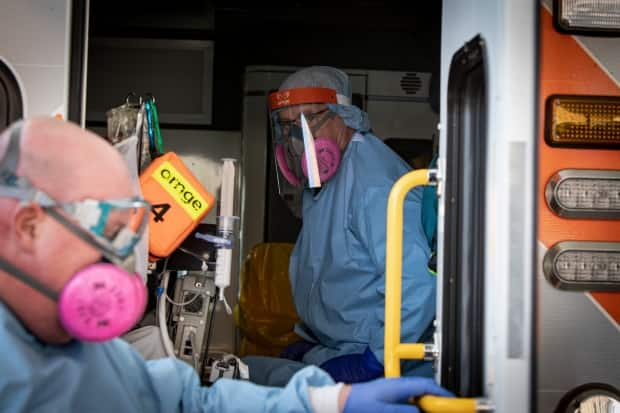See where Ornge has moved Ontario patients to avoid hospital COVID-19 overflow

Ornge and local paramedic services have transferred more than 2,100 patients since the start of the year, under orders to keep intensive-care units at Ontario hospitals from overflowing.
Sick, intubated COVID-19 patients have been put into ambulances, helicopters and planes, and rushed from one Ontario hospital to another with more capacity. Patients have been moved as far as Toronto to Thunder Bay, a distance of 1,400 kilometres.
Scroll down to see list of hospitals where patients were transferred to and from
As of May 12, Ornge — an air ambulance and ground transportation service responsible for transferring some of the sickest patients — reports it and local paramedic services had moved 2,134 patients, going over the top with the peak of the third wave. In April, 1,133 patients were transferred, while 333 have already been moved in May.
"The volume of these patients is what is very different right now," says Dr. Bruce Sawadsky, Ornge's chief medical officer. "It's a bit like a symphony. Everything has to flow together perfectly."
That involves a suite of ventilators, infusion pumps and monitors. Sawadsky typically does administrative work. But all the demand means he's had to assist with patient transfers too, something he would typically never do.
The bulk of the transfers are happening from hard-hit hospitals in the Greater Toronto Area (GTA). Brampton Civic Hospital, and Etobicoke General and Humber River in North York top the list, transferring out hundreds of patients each.
The below data represents transfers made by Ornge and local paramedic services, ordered to hospitals since January. The numbers also do not include regular Ornge transports.
Though dominated by the GTA, smaller regions are represented further down the list, including Barrie's Royal Victoria Regional Health Centre, Windsor Regional Hospital's Met Campus and Thunder Bay Regional Health Sciences Centre.
Notably, eight patients were transferred from a mine, 500 kilometres north of Thunder Bay.
Ornge says the majority of these transfers have tested positive for COVID-19, but non-COVID-19 patients get transferred too.
"It's a difficult task," said Sawadsky. "These patients are not easy. They are critically ill … they require very high amounts of oxygen."
Ontario Health told CBC an additional 1,383 patients, requiring acute and alternate levels of care were also transferred during the third wave between March 1 to May 3, 2021. It would not provide a breakdown of where patients were transferred to and from.
Where are patients sent?
Vaughan's new Cortellucci Hospital has accepted the most patient transfers, given it is dedicated to COVID-19 right now. That's followed by Halton Healthcare Services in Oakville and Kingston General Hospital further afield.
Renate Ilse, Kingston Health Sciences Centre's vice-president of patient care, gets the daily email, telling her how many sick patients are being transferred her way and the number of hours her team has to prepare.
"We basically take anything that we get told to take," she said. "Anybody that is kind of quiet, quieter, helps out."
Hospitals have helped in Hamilton, London, Kitchener, Windsor, Sudbury. Even smaller hospitals have taken on patients too, like Owen Sound Regional Hospital, Brockville General Hospital and Ross Memorial Hospital in Lindsay.
Though transfers come daily, Ilse said there's still anxiety. Kingston's COVID-19 rate has stayed relatively low, so some are wary about the virus knowingly being brought into their region.
"People worry constantly."
She's not aware of any virus spread that's happened between other staff and patients in hospital, and said accepting patients is Kingston's way of helping out the harder-hit Toronto area.
Currently, Kingston is looking after 16 COVID-19 patients from outside its area and five locals.
"If the situation were reversed, we would hope that the GTA would reach out and help us."
Who makes transfer decisions?
That falls on a team called the Critical Care COVID-19 Command Centre, like mission control for ICUs and hospitals in the province.
It meets daily, monitoring vitals on hospital capacity, and deciding who and who doesn't have space for patients. That means making sure there's wiggle room left for non-COVID-19 emergencies — heart attacks, strokes, car accidents.
The command centre tells hospitals how many patients need to be transported to maintain or create capacity.

Hospitals don't need a patient or their decision-maker's consent before they are transferred. This is new protocol introduced in April under emergency order to avoid overwhelming medical facilities. It has been extended until at least June 2, as Premier Doug Ford extended the stay-at-home order Thursday.
Sawadsky said families have largely been understanding of this policy.
"You just have to think about the next person in your community that may have another critical illness," he said. "They need to have the ability to care for that patient, and if we don't move them out, then they can't."
Monthly patient transfer breakdown
Data from Ornge's Emergency Operations Centre as ordered to create ICU capacity. Patient transfers made by Ornge and local paramedic services:
January 2021: 209.
February: 217.
March: 242.
April: 1,133.
May 1-12: 333.
The Ontario Ministry of Health says if a patient is ready to be discharged, the receiving hospital has been told to help arrange "safe transportation home." It explicitly says the transfer home shouldn't cost the patient anything.
Ilse said her out-of-town patients have been grateful.
"No complaints about getting shipped to Kingston. Just happy that they've recovered and had a good outcome."

 Yahoo Finance
Yahoo Finance 